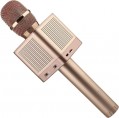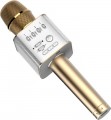Frequency range
The range of audio frequencies normally perceived and processed by a microphone.
The wider this range — the fuller the signal, the less likely that too high or low frequencies will be missed due to the imperfection of the microphone. However, in this case, it is worth considering some nuances. First of all: a wide frequency range in itself does not guarantee high sound quality — a lot also depends on the type of microphone (see above) and its frequency response, not to mention the quality of other components of the audio system. In addition, a large width is also not always really necessary. For example, for normal transmission of human speech, a range of 500 Hz — 2 kHz is considered sufficient, which is much narrower than the general range perceived by the human ear. This general range, in turn, averages from 16 Hz to 22 kHz, and also narrows with age. Do not forget about the features of the equipment to which the microphone is connected: it is hardly worth specifically looking for a model with an extensive range, if, for example, the amplifier to which it is planned to be connected severely “cuts off” the frequencies from above and/or below.
Sound pressure
The maximum sound pressure perceived by the microphone, at which the harmonic oscillation coefficient does not exceed 0.5% — in other words, the highest sound volume at which no noticeable interference occurs.
The higher this indicator, the better the microphone is suitable for working with loud sound. Here it is worth considering that the decibel is a non-linear quantity; in other words, an increase in volume from 10 dB to 20 dB or from 20 to 40 dB does not mean a 2-fold increase in volume. Therefore, when assessing, it is most convenient to refer to comparative tables of noise levels. Here are some examples: a level of 100 dB roughly corresponds to a motorcycle engine or subway car noise; 110 dB — helicopter; 120 dB — the work of a demolition hammer; 130 dB, comparable to the sound of a jet aircraft taking off, is considered a pain threshold for a person. At the same time, many high-end microphones are able to work normally at a sound pressure of 140 – 150 dB — and this is a noise level that can cause physical damage to a person.
Material
The material from which the microphone body is made.
— Plastic. The main advantages of plastic are low cost, light weight and complete insensitivity to corrosion. At the same time, it is considered less reliable than metal, due to its relatively low strength (high-strength varieties of plastics exist, but in the case of microphones, it is usually easier to use metal after all). Therefore, this material is popular mainly among models for which lightness and miniature are important — primarily lapel,
head and those that
are installed on a video camera(see "Destination"). It is also often found in computer and laptop devices, but
plastic microphones for vocals usually belong to the entry-level price category.
— Metal. Metal is more expensive than plastic and has more weight. On the other hand,
metal microphones are much stronger and more reliable, besides, a microphone in such a case gives the impression of "solidity" (not least due to massiveness). This option is popular with mid to high end vocal,
studio and
instrument microphones.
In box
- Receiver. Receiver used on wireless models (see Features/Capabilities). The receiver, in essence, plays the role of a radio adapter: it connects to an amplifier or other audio equipment in the classic wired way and transmits the signal from the microphone to this equipment. For more information about the included receiver, see “Radio System”,
— Transmitter. A transmitter used in systems with a wireless connection (see “Functions/capabilities”), or more precisely, a transmitter designed as a separate device. Miniature microphones (primarily lavalier and headset) have this design, in which the housing dimensions do not allow the transmitter to be built directly into the device: the microphone is connected to an external transmitter using a wire, the latter is usually hung on the belt. The presence of a separate transmitter is usually a sign of a compact microphone; and one of the practical advantages of this design is that the microphone can be detached and connected to other equipment (not necessarily a transmitter).
—
Monitor mount. A device for attaching a microphone to a computer monitor. For obvious reasons, it is used only in models for computers (see “Purpose”). This feature is especially useful in cases where there is very little free space on the table where the computer is located, or the microphone cannot be placed on the table in the optimal place. The mount can also be useful for working with a laptop, alt
...hough specialized microphones are usually more convenient.
— Holder for stand. A mount in the form of a characteristic round cradle designed to place a microphone on a stand, tripod or other device. Used primarily with vocal and instrumental models (see “Purpose”), it allows you to quickly remove and install the microphone on a stand - which is useful, in particular, during concerts and other public performances. Holders are also sold separately, but buying a model with a complete mount is often more convenient - such a mount is optimally compatible with the microphone and does not require wasting time searching and selecting.
— Anti-shock suspension (“ spider ”). Special shock-absorbing suspension used with studio microphones (see “Purpose”); The slang name "spider" comes from its characteristic shape. The need to use such a suspension is due to the fact that on a regular stand, a microphone can experience various shocks and vibrations (from the operation of equipment nearby, from objects falling on the floor, and even from people’s steps), which create interference in the sound. “Spider” compensates for such shocks and reduces interference to almost zero; At the same time, a complete suspension is more convenient than one purchased separately due to the fact that it is, by definition, compatible with a microphone.
— Pop filter. Such a filter is a plate, usually round, installed in front of the microphone when working with voice - most often during recording; Accordingly, this function is used primarily with studio microphones (see “Purpose”). The protective screen allows sound to pass through well, but it blocks the flow of air that occurs during breathing - thus preventing the appearance of characteristic interference from “exhaling into the microphone.” Another purpose of pop filters is to protect against small splashes of saliva, which can cause corrosion and negatively affect the longevity of the microphone.
— Wind protection. The windscreen most often takes the form of a distinctive “tip,” usually foam, that fits over the microphone; at the same time, in miniature models (for example, head ones, see “Purpose”) the design may be different. However, in any case, the purpose of such devices corresponds to the name: to protect the microphone from exposure to intense air currents that can cause interference. Note that the matter is not limited to wind - a person’s breathing can also become a source of interference if the microphone is located close to the mouth.
— Detachable cable. The ability to detach the cable from the microphone not only makes storage and transportation easier, but also allows you to replace the supplied cable with another if circumstances require it (for example, to connect through a different interface, see above).
- Tripod. A tripod is essentially a portable tripod designed to mount a microphone on a table or other similar surface. This eliminates the need to hold the device in your hand or organize a stand “from scrap materials.” Such tripods are also sold separately, but it is usually more convenient to buy a set; For more details, see "Rack Holder".
- Power adapter. A device that allows you to supply a microphone of a condenser or electret type (see above) with the phantom power required for operation from a regular household 230 V outlet. Thanks to this, it becomes possible to connect the microphone even to tech amplifiers (receivers, players, etc.) that do not have phantom power inputs.
— Case/case. A case is usually called a container made of hard materials, while a cover is usually made of soft materials. The only key difference between them is the degree of protection - the cases are more shock-resistant. But the basic purpose is the same: storing and transporting a microphone in a case/cover is much more convenient than without such a device (in particular, because additional included accessories can usually also be placed inside).
— Charging case. A case is a case made of hard material that simultaneously plays the role of a charger. This feature is very popular in wireless models. The charging case usually has its own battery and the microphone (transmitter) and receiver are charged from this battery; This design provides additional convenience in several ways. Firstly, the case, in fact, also serves as a power bank - an autonomous power source; The capacity of such a “power bank” may vary, but it is usually enough for several full charges. Secondly, the ability to charge small microphones directly in the case reduces the risk of losing them. Thirdly, the charging procedure itself is quite convenient - you just need to connect the cable to the case.
Note that, in addition to the above, manufacturers may include other accessories in the kit - for example, separate clips for attaching lavalier microphones, battery chargers, cleaning wipes, etc.
